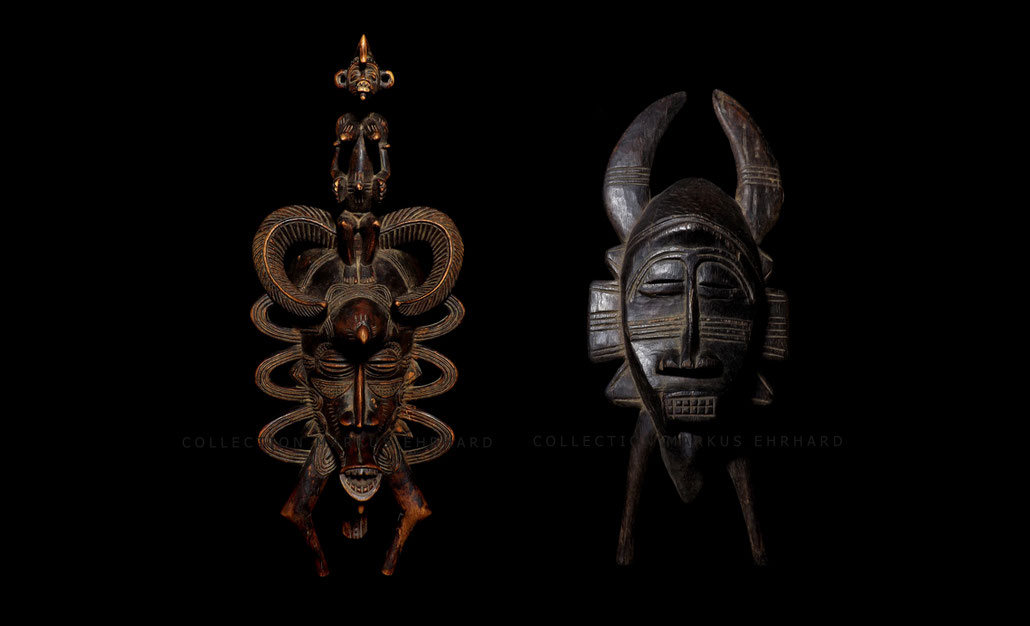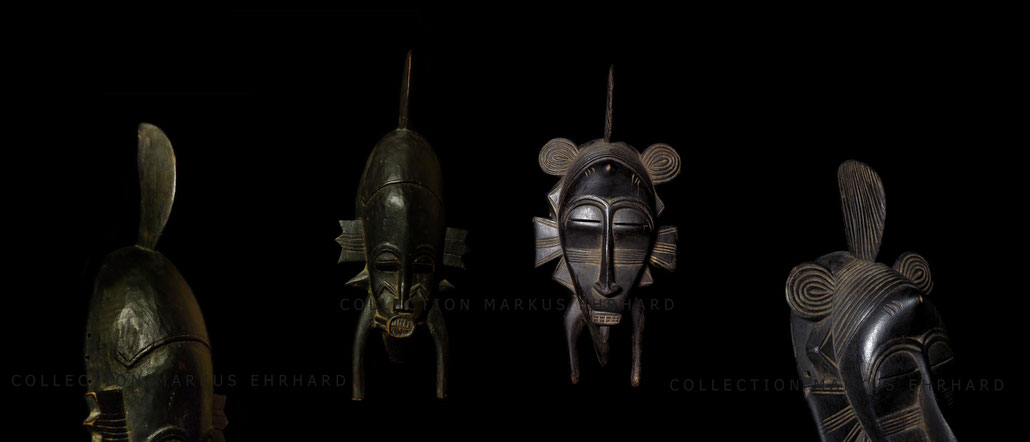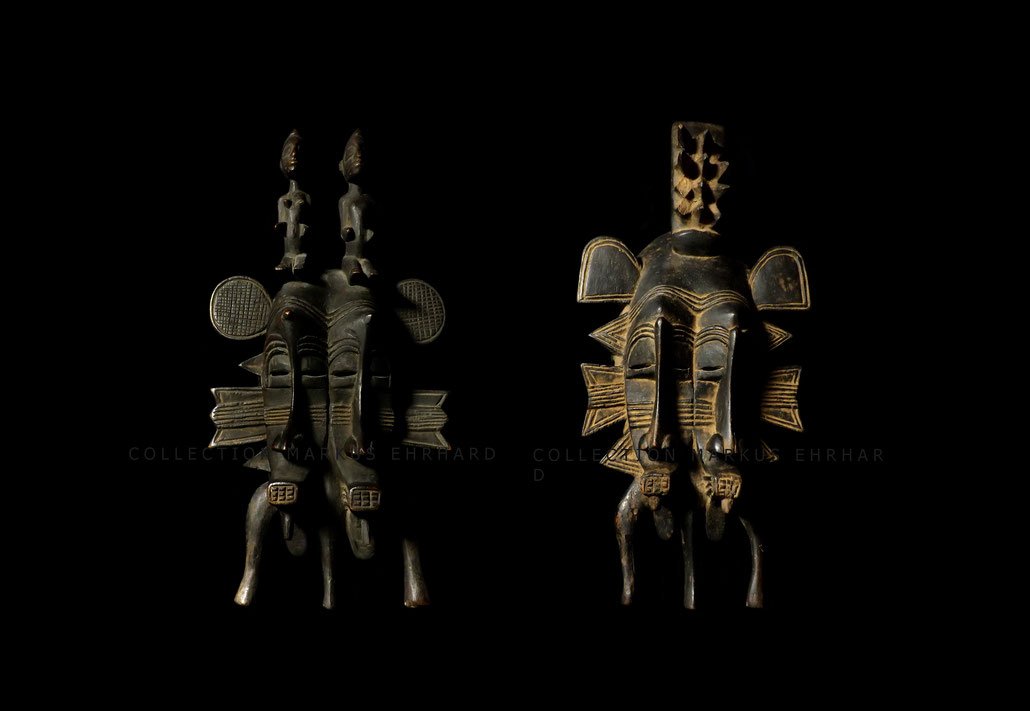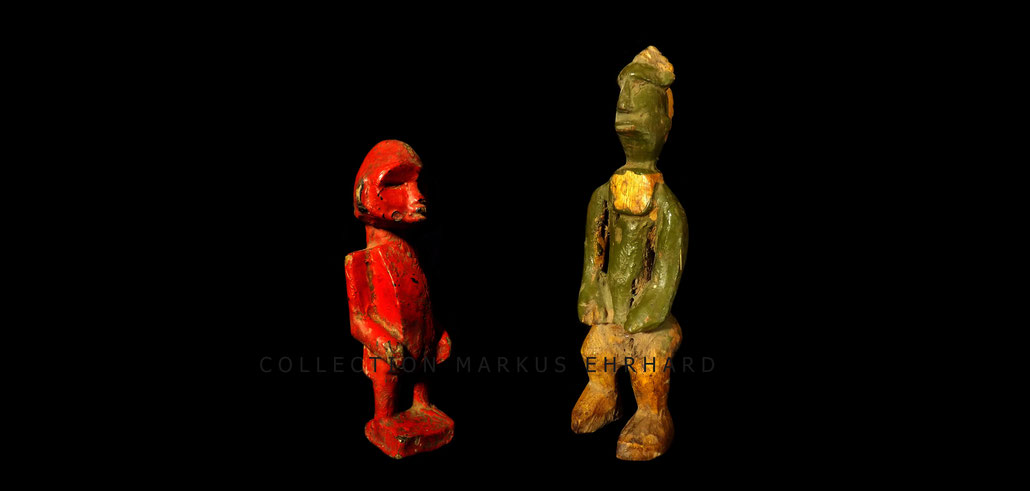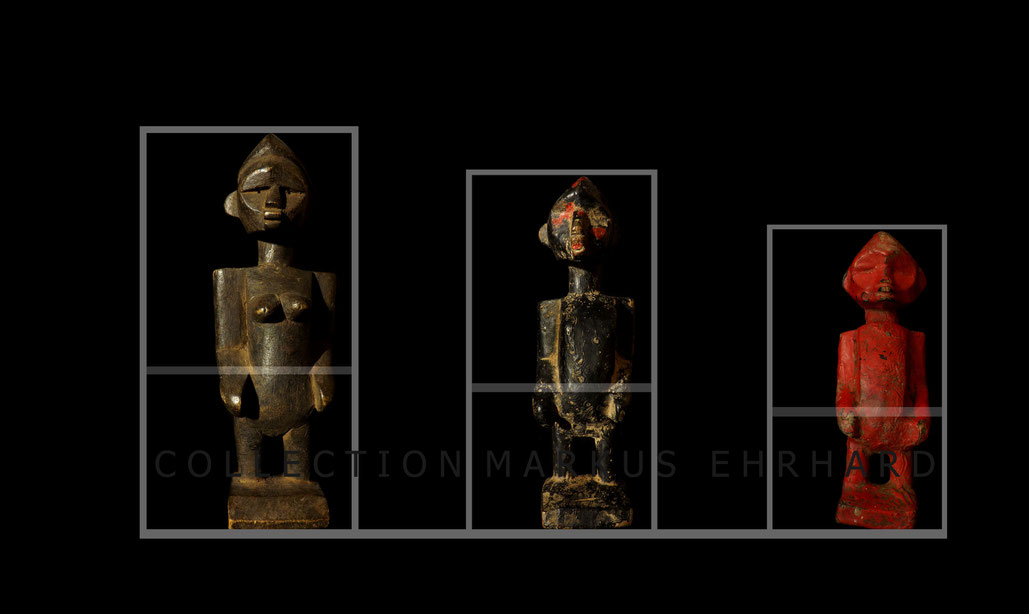Senufo · 27. April 2017
Airport-art is a no-go? Right? Once a collector said "I don't want fleas in my house!" Ok, that's a statement. But I say, collect Airport-art too! Buy it and compare with other objects! You will see the differences immediately. And I will tell you why Airport-art is also important to look at: In case of the Senufo culture, the sculpture is not getting documentated as we do by counting, measuring and weighting. The Senufo preserve their sculpture by repeating.
Senufo · 27. April 2017
The description of a masterpiece is mostly defined by a high price. Some masterpieces are rare, no doubt, and so it is difficult to compare. But what makes a masterpiece a masterpiece? Both shown masks are authentic Kpelié masks used in tribe. Both are carved in typical traditional Senufo style. Both masks are truthfully and sincere. The right mask, carved by Melié Coulibaly (+1952), a Koulé from Landiougou, has a raw and rudimentary look. The carving looks simple, beside the traditional...
Senufo · 12. April 2017
Fédiofègue "Fédi" Koné had constant problems in casting his Kpelié masks. On images Karl-Heinz Krieg made in 1973 it is documentated, that Fédi placed the casting channels on the front of the face. If he would have placed these channels on the bottom, for example using the side legs as inflow for the alloy, and casted the mask upside down, his cast would have been in a much better quality. Even his late masks show unregular surfaces, gaps and holes. In interviews with Karl-Heinz Krieg...
Senufo · 12. April 2017
Collecting several objects from one carver gives the oportunity to compare the progress in technique, shape and proportion of a carver. The period of active working of Doh Soro is very short, because he suffered from mental disease at the age of 35. In average a Koulé starts to learn carving in the age of 12. Doh's timeframe to look at is about 20 years. Doh Soro had an immense feeling for shape and proportion right on in his first maternité statues. The volume of the bodies of the mother and...
Senufo · 10. April 2017
Upfront, there is no myth about the burning blades, it is the truth, that the Numu carve their objects with glowing knifes. The Numu are the smithers of the G'ué (also Gouin or Guin), a subgroup of the Senufo living around the City of Banfora in Burkina Faso. The legend says, that they own the fire and metal. The Numu can be compared with the Fono, the Senufo smithers working with wood, from Ivory Coast. Not much is known about the G'ué as of the Numu in particular, they are not researched as...
Senufo · 10. April 2017
Bolope (or Bolopé), north of Boundiali, next to the Mali border, was a carving centre of the Senufo until mid last century. Many carvers moved then southwards to Nafoun or Ouezomon. The left very dark Kpelié was collected by a French couple, who lived as colonizers in Bolope from 1920 to 1930. The right mask was carved by Kadohognon Coulibaly, who died 1953 in Bolope. Both masks vary in their interpretation of shape, proportion and decoration elements. But both masks have the weird looking...
Senufo · 05. April 2017
Same place, same time and two carvers. Nono Koné and Wahana Dairassouba lived worked at the same time in Tiogo. Both were Koulés who carved in the traditional Senufo style. It is not confirmed if both stood in family relation. Having these two masks of the same genre, gives the possibility to compare. Arrangement, composition and proportion are nearly identical. Beside the different centre tops, like the Tugubele couple of Nono's mask and the Kapok fruit at Wahana's mask, both masks display...
Senufo · 30. März 2017
At first view, it is not possible to say for sure, that these two statues belong to the Senufo style. Both are colored and the style elements are certainly not typically Senufo. But by word to mouth these two male statues were determined as Nyingife figures, which provide protection for the owner. Though these two look pretty extreme, the owner was special too. It is said, that this "man was not from this world". It is interpretation, what it could mean, not to be from this world. I could be a...
Senufo · 28. März 2017
Songuifolo Silué (*1914 +1986) was a very productive Fono from Sirasso. He carved for about 60 years, before he went blind in the early 1980ies. Beside the traditional style, in this area called the Ouézomon-style, Silué created in the 1930ies a minimalistic handwriting. As a famous master he had many orders. These modern looking Nyingife statues for instance might be the result of an effective production. In projection he and his assistants carved more than 1000 objects in his lifetime. The...
Senufo · 27. März 2017
"Ha! - there is not a second, better carver than Sabariko", said Zangvagnan Koné about his uncle Sabariko Koné in an interview with Karl-Heinz Krieg. Sabariko Koné (+1949) lived and worked in Ouézomon. Nearby Nafoun and Korhogo, Ouézomon was/is one of the carver's centres of the Senufo in Ivory Coast, where Koné also founded a school for carvers. Beside his two sons, Yéralo and Meinyerigué Koné, Tchètin Bêh Konaté was one of his students. Songuifolo Silué from Sirasso knew Sabariko...

Welcome to the first archive documentating the artwork of 26 named Senufo carvers from 1900 till today. We present antique and recent sculptures of so-called masters and not that famous carvers.
All our images have copyright markings. Feel free to download our content and images. In case you publish or share our content or an image on other platforms, like Facebook or Pinterest, please name the source and link to this website. All images are highly detailed printed with more information in our books, available at Ornito.


